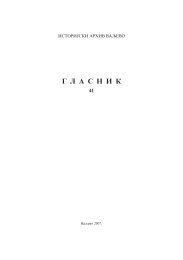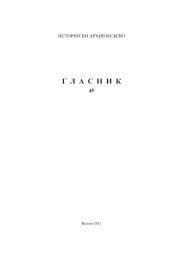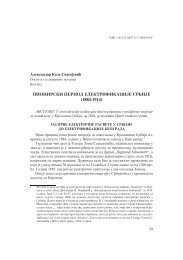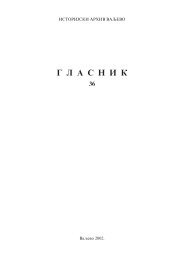glasnik - Istorijski arhiv Valjevo
glasnik - Istorijski arhiv Valjevo
glasnik - Istorijski arhiv Valjevo
Create successful ePaper yourself
Turn your PDF publications into a flip-book with our unique Google optimized e-Paper software.
Kula Nenadovi}a i {anac na Kli~evcu iz ugla istorijske arheologije<br />
Summary<br />
At the beginning of 2010, Ministry of culture granted Cultural Heritage Preservation<br />
Institute of <strong>Valjevo</strong> financial fund for continuance of reconstruction project of<br />
moat around Tower of Nenadovi} family. During the preparation of the reconstruction<br />
project, the problem of the appearance and construction of defensive walls -<br />
rampart emerged. There is only a handful of information, gained mostly from the<br />
rare descriptions of contemporaries, on how the trench and moat looked like. The<br />
goal of the research was to discover and document fortification construction elements<br />
around the tower. Documentation from older archeological excavations conducted<br />
in 1985 was also used in this article. On the basis of research and other available<br />
documentation, the appearance of fortifications, various stages of use and actual<br />
time of its origin were determined. In 2010, yet another cross-section of western<br />
part of rampart was made, in the area for which was assumed not to be disturbed<br />
by subsequent diggings. Total investigated area is now 60 sqm.<br />
Information gained with this archeological research and comparing newly found<br />
data with documentation from previous researches, helped deducting several new<br />
conclusions. (Fig. 1-4).<br />
In the area around the tower there is no trace of older fortification than 1813, that<br />
is before Austrian-Turkish wars. However, there are findings that point to medieval<br />
and prehistoric traces of life. Being that only small area was thoroughly explored,<br />
we cannot say with certainty for what purposes the space around the tower was used<br />
for in these periods.<br />
The fortification around the tower was consisted of moat, funnel shaped in<br />
cross-section, 3 m wide and a rampart made out of the soil dug out from the moat.<br />
The rampart was 1.5 m high, and was wide around 3 m. The outer and inner trench<br />
construction was made out of wooden profiles, consisted of vertically placed<br />
wooden beams, with wattle wrapped in between. The space between wooden profiles<br />
was packed with soil dug from the moat. The moat was entered by wooden<br />
bridge which could easily be removed. The trench had an option of additional<br />
strengthening by wooden shelters and baskets. The purpose of all of this was to provide<br />
shelter for archers and artillery, which could have been standing on the very<br />
rampart (Fig. 6). This type of fortification was used till 1815.<br />
During subsequent restorations, the trench was made in the form of battlement.<br />
The trench which is mentioned in historical sources, related to Austrian-Turkish<br />
wars and the First Serbian Uprising, is situated on elevation point 287, 1200 m north<br />
of the tower, placing it on the most dominant point with best view on the whole surrounding<br />
terrain. Many of fortifications from that time had similar positions. (Fig. 7)<br />
Satellite and airborne images of Kli~evac hill clearly show outlines of the trench.<br />
Since the XVIII century to the present day, this area is continually used for military<br />
purposes as a moat, a moat with a warehouse, storage and military training area. The<br />
rampart today is roughly rectangular, with rounded corners, measuring 120 x 100 m,<br />
corresponding to presentation on Austrian map dated from 1789 and plans from<br />
1853 and 1854.<br />
19






